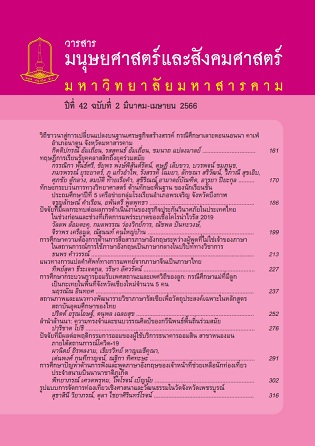ทฤษฎีการเรียนรู้ยุคคลาสสิกถึงยุคร่วมสมัย
Main Article Content
บทคัดย่อ
บทความนี้มีวัตถุประสงค์ที่สำคัญ 3 ประการ คือ (1) เพื่อให้ผู้อ่านได้รู้จักและทำ ความเข้าใจเกี่ยวกับทฤษฎีการเรียนรู้ยุคคลาสสิคและยุคร่วมสมัย (2) เพื่อให้ผู้อ่านได้เห็นแนวทางการจัดการเรียนรู้ด้วยทฤษฎีการเรียนรู้ในแนวทางต่างๆ พอสังเขป และ (3) เพื่อให้ผู้อ่านได้เห็นวิวัฒนาการของแนวคิดว่าด้วยการอธิบายกลไกการเรียนรู้ของมนุษย์ซึ่งถือว่าเป็นสิ่งที่ยากต่อการทำ ความเข้าใจเรื่องหนึ่งซึ่งในบทความนี้ผู้เขียนใช้วิธีการสังเคราะห์(Synthesis) เอกสารหนังสือและบทความที่ว่าด้วยทฤษฎีการเรียนรู้ต่างๆ ที่น่าสนใจ โดยในตอนต้นของบทความจะนำเสนอปฐมบทของการศึกษาว่าด้วยการเรียนรู้ ตอนกลางของบทความจะนำ เสนอทฤษฎีการเรียนรู้ในชุดคลาสสิคและทฤษฎีการเรียนรู้ชุดร่วมสมัย ได้แก่ ทฤษฎีการเรียนรู้ทฤษฎีเชื่อมโยงสัมพันธ์ทฤษฎีการเรียนรู้แบบการวางเงื่อนไขการกระทำ ทฤษฎีพัฒนาการทางสติปัญญา ทฤษฎีการเรียนรู้ทางปัญญาสังคม ทฤษฎีการเรียนรู้ที่เท่าทันต่อการเปลี่ยนแปลง ทฤษฎีการเป็นตัวแทนและการเรียนรู้แบบการค้นพบ ทฤษฎีการเรียนรู้ทางสังคมทฤษฏีพหุปัญญา ทฤษฎีการเรียนรู้เชิงสังคมและวัฒนธรรม ทฤษฎีมิติด้านอารมณ์ของการเรียนรู้และในตอนท้ายของบทจะนำเสนอแนวโน้มของการศึกษาและการวิจัยทางด้านการเรียนรู้ในอนาคต
Article Details
เอกสารอ้างอิง
กิตติธัช บุญนาคแก้ว และคณะ. (2564). การพัฒนากระบวนการจัดการเรียนรู้ตามทฤษฎีการสร้างความรู้ด้วยตนเองร่วมกับแนวคิดการเรียนรู้แบบร่วมมือเพื่อส่งเสริมทักษะการทำงานร่วมกับผู้อื่นอย่างมีความคิดสร้างสรรค์. วารสารวิชาการ ครุศาสตร์สวนสุนันทา, 5(2) : 12-23.
เจษฎา อังกาบสี. (2561). จิตวิทยาพัฒนาการ. แดเน็กซ์ อินเตอร์คอร์ปอเรชั่น.
ทิศนา แขมณี. (2562). ศาสตร์การสอน (พิมพ์ครั้งที่ 23). สำนักพิมพ์จุฬาลงกรณ์มหาวิทยาลัย.
วิทยากร เชียงกูล. (2552). จิตวิทยาวัยรุ่น: ก้าวข้ามปัญหาและพัฒนาศักยภาพด้านบวก. พิมพ์ลักษณา
ศุภชัย สมพงษ์, และประภาศ ปานเจี้ยง. (2564, 25 มิถุนายน). ผลการจัดการเรียนรู้ตามแนวคิดของธอร์นไดค์ที่มีต่อโสตทักษะในรายวิชาดนตรีสากล สำหรับนักเรียนชั้นมัธยมศึกษาปีที่ 1 [เอกสารการนำเสนอ]. การประชุมหาดใหญ่วิชาการระดับชาติและนานาชาติ ครั้งที่ 12, สงขลา, ประเทศไทย.
สมโภชน์ เอี่ยมสุภาษิต. (2549). ทฤษฎีและเทคนิคการปรับพฤติกรรม. สำนักพิมพ์แห่งจุฬาลงกรณ์มหาวิทยาลัย
สุรางค์ โค้วตระกูล. (2556). จิตวิทยาการศึกษา. โรงพิมพ์แห่งจุฬาลงกรณ์มหาวิทยาลัย.
หทัยทิพย์ ธรรมวิริยะกุล (2562). การสร้างชุมชนการใช้หลักฐานการแพทย์เชิงประจักษ์ในเวช ปฏิบัติครอบครัว : การประยุกต์ทฤษฎีคอนสตรัคติวิสต์เชิงสังคม. วารสารระบบบริการปฐมภูมิและเวชศาสตร์ครอบครัว, 2(2), 23-30.
อธิปัตย์ บำรุง. (2563). แนวคิดและทฤษฎีเกี่ยวกับการเล่นเพื่อส่งเสริมพัฒนาการและการเรียนรู้ของเด็ก. สำนักงานบริหารและพัฒนาองค์ความรู้ (องค์การมหาชน) มหาวิทยาลัยมหิดล.
Ahmed, S. (2004). The Cultural Politics of Emotion, Edinburgh: Edinburgh University Press.
Babakr, Z. H., Mohamedamin, P., & Kakamad, K. (2019). Piaget’s Cognitive Developmental Theory: Critical Review. Education Quarterly Reviews, Vol.2, No.3, 517-524. doi:https://doi.org/10.31014/aior.1993.02.03.84
Bauman, Z. (2006). Liquid Fear. Polity Press.
Benson, N., Ginsburg, J., Grand, V., & Lazyan, M. (2012). The Psychology Book, Big Ideas Simply Explaine. DK Publishing.
Bourke, J. (2005). Fear: A Cultural Histor. Virago.
Cherry, K. (2022). Piaget's 4 Stages of Cognitive Development Explained : Background and Key Concepts of Piaget's Theory. Verywell Mind.
Davis, K, Christodoulou J. A., Seider S, & Gardner, H. (2011). The Theory of Multiple Intelligences. In R. J. Sternberg, & S. B. Kaufman (Eds.) Cambridge Handbook of Intelligence (pp. 485-503). Cambridge University Press.
Dweck C. S. .(2006). Mindset : The New Psychology of Success. Ballantine Books.
Fawcett, L. M., & Garton, A. F. (2005). The effect of peer collaboration on children's problem‐solving ability. British Journal of Educational Psychology, 75(2), 157-169. doi:https://doi.org/10.1348/000709904X23411
Fisher, D., Frey, N., & Hattie. J. (2016). Visible learning for literacy. Calgary Regional consortium. Corwin.
Gardner, H. (1999). Intelligence Reframed: Multiple Intelligences for the 21st Century. Basic Books.
Gardner, H. (2006). Multiple Intelligences: New Horizons (completely revised and updated). Basic Books.
Gardner, H. (2013). Frequently asked questions—multiple intelligences and related educational topics. Retrieved from http://www.pz.harvard.edu/sites/default/files/faq.pdf.
Gill, T. (2007). No Fear: Growing Up in a Risk Averse Society. Calouste Gulbenkian Foundation.
Hascher, T. (2010) ‘Learning and emotion: perspectives for theory and research’, European Educational Research Journal, 9, 1: 13–28. doi:https://doi.org/10.2304/eerj.2010.9.1.13
Hattie, J. (2008). Visible Learning: A Synthesis of Over 800 Meta Analysis Relating to Achievement. Taylor & Francis.
Hattie, J. (2012). Visible Learning for Teachers: Maximizing Impact on Learning. Taylor & Francis.
Hattie, J. (2013). Visible Learning and the Science of How We Learn. Taylor & Francis.
Hattie, J. (2015). The applicability of Visible Learning to higher education. Scholarship of Teaching and Learning in Psychology, 1(1), 79-91. doi:https://doi.org/10.1037/stl0000021
Hattie, J. A. T., & Donoghue, G. M. (2018). A model of learning Optimizing the effectiveness of learning strategies. In K. Illeris (Ed.), Contemporary Theories of
Learning (pp. 97 - 113). Routledge, Taylor & Francis Group.
Illeris, K. (2018). Contemporary theories of learning: learning theorists, in their own words. Routledge, Taylor & Francis Group.
Karadut, A. P. (2012). Effects of E. L. Thorndike’s Theory of Connectionism Rudiments on Developing Cello Playing Skills for Beginners. Procedia - Social and Behavioral Sciences, 69(Iceepsy), 298–305. doi:https://doi.org/10.1016/j.sbspro.2012.11.413
Knight, J. (2019). Instructional Coaching for Implementing Visible Learning: A Model for Translating Research into Practice. Education Sciences. 9(2), 1 - 16. doi:https://doi.org/10.3390/educsci9020101
Lave, J. (1988). Cognition in practice. Cambridge, England: Cambridge University Press.
Lave, J. (1991). Situated learning: Legitimate peripheral participation. Cambridge University Press.
Meece, J. L. (2002). Child and adolescent development for educators, (2nd edition). McGraw-Hill.
Merriam-Webster. (2022). Merriam-Webster Dictionary. Merriam-Webster.
Nairne. J. S. (2000). Psychology : the adaptive mind, (2nd edition). Australia : Wadsworth.
Olson, H. M. (2013). An introduction to theories of learning (9th edition). Routledge, Taylor & Francis Group.
Olson, M. H., & Hergenhahn, B. R. (2013). An Introduction to Theories of Learning (9th edition). Routledge, Taylor & Francis Group.
Ozdem-Yilmaz, Y., Bilican, K. (2020). Discovery Learning—Jerome Bruner. In: Akpan, B., Kennedy, T.J. (eds) Science Education in Theory and Practice. Springer Texts in Education. Springer, Cham. doi:https://doi.org/10.1007/978-3-030-43620-9_13
Piaget, J. (1970). Piaget’s Theory (G. Gellerier & J. Langer, Trans.). In: P.H. Mussen (Ed.), Carmichael’s Manual of Child Psychology (3rd Edition, Vol. 1). Wiley.
Raymond, G. (2016) Behavior Modification: Principles and Procedures, (6th edition). Pearson Education.
Schunk, H. D. (2012). Learning theories (6th ed.). Pearson Education Inc.
Schunk, D. H. (2012). Learning Theories, an Educational Perspective (6th edition). Pearson Education Inc.
Shabani, K. (2016). Applications of Vygotsky’s sociocultural approach for teachers’ professional development. Cogent Education, 3(1), 1252177. doi:https://doi.org/
1080/2331186X.2016.1252177
Shabani, K., Khatib, M., & Ebadi, S. (2010). Vygotsky's zone of proximal development: Instructional implications and teachers' professional development. English Language Teaching, 3(4), 237-248. doi:https://doi.org/10.5539/elt.v3n4p237
Shunk, D. H. (2006) Learning Theories: An Education Perspective. Pearson Education,
Slavin, R. E. (2009). Educational Psychology: Theory and Practice (9th Ed.). Pearson Education.
Slawin, R. E. (2018). Educational Psychology: Theory and Practice. Pearson.
Soysa, C. K., & Weiss, A. (2014) ‘Mediating perceived parenting styles-test anxiety relationships: academic procrastination and maladaptive perfectionism’, Learning and Individual Differences, 34: 77–85. doi: https://doi.org/10.1016/j.lindif.2014.05.004
Thorndike L. E. (1966). Human Learning. M.I.T. Press.
Tin, T. B. (2003). Does talking with peers help learning? The role of expertise and talk in convergent group discussion tasks. Journal of English for Academic Purposes, 2(1),
-66. doi:https://doi.org/10.1016/S1475-1585(02)00033-4
Tudge, J., & Scrimsher, S. (2014). Lev S. Vygotsky on education: A cultural-historical,
interpersonal, and individual approach to development. In Educational
psychology: A century of contributions (pp. 207-228). Routledge, Taylor & Francis Group.
Wenger, E. (2018). A social theory of learning. In K. Illeris (Ed.), Contemporary Theories of
Learning (pp. 219-228). Routledge, Taylor & Francis Group.
Wetherell, M. S. (2014) ‘The turn to affect’, paper presented at Taking ‘Turns’: Material, Affective and Sensory ‘Turns’ in the Academy, University of Manchester, 3 July.
Woolfolk, A. E. (2010). Education Psychology (11th edition). Pearson.
Woolfolk, A. E. (2016). Educational Psychology (13th edition). Pearson Education.
Zaretsky, V. K. (2016). Vygotsky's principle “One step in learning —one hundred steps in development”: from idea to practice. Cultural-Historical Psychology, 12(3), 149-188. doi:https://doi.org/10.17759/chp.2016120309
Zimbardo, P. G., Johnson, R., & McCann, V. (2017). Psychology: Core Concepts. Pearson International Publishing.


